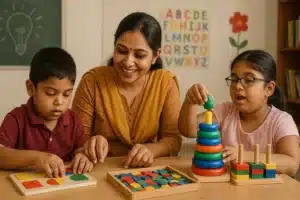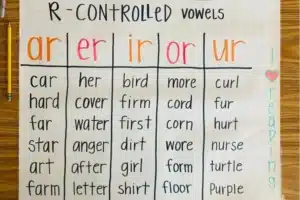
Inclusivity Meaning lies deeper than just the academic aspect of children; it aims to build a solid mindset for children and Society to give children, irrespective of their learning differences, to be a respectable part of the mainstream classroom. Inclusivity makes it possible for every child to be celebrated for their uniqueness, and where children value and deeply respect each other.
Inclusivity is the only approach that ensures equal allocation of opportunities, promoting a more sensitive and culturally strong society.
What is Inclusive Education?
Inclusive Education implies creating conducive classrooms that give equal importance to the learning styles of all children, irrespective of their backgrounds. It means that children, regardless of their abilities, competencies, and learning preferences, acquire education in a single classroom. It eradicates the concept of children being secluded in a different resource room and promotes a shared learning environment for all, ensuring every child succeeds, leading wholesome lives, and establishing a bright future.
To download the brochure of the Diploma in Special Education Course, Click Here!
For more details on the Diploma in Special Education Course, Call/WhatsApp at +919321024137 / +919869866277
Here is what is included in inclusive education:
All students together
Children of different calibre, disability, and cultural diversity get a chance to share the same classroom, helping them to gain valuable insights into each other’s lives, allowing room for interaction, understanding, equality, and acceptance.
Different needs need to be fulfilled
When the child’s performance is not up to par, considering the outcomes mentioned as per the IEP’s educators take special efforts to modify the teaching methods or learning styles to adapt to the child’s needs.
Differentiated instruction
Educators employ a range of methods and adaptable and flexible teaching strategies to meet a greater number of students’ learning styles, learning capabilities, and learning rates, so that every student can benefit from learning the curriculum.
Positive and supportive atmosphere
Inclusive classrooms help children feel secure, giving them the confidence to mould comfortably into a mainstream classroom, encouraging them to be expressive about their needs.
Collaboration and communication
Inclusive education is successful when educators, families, and specialists work together to construct support for individualized learning and adaptation without leaving any child behind.
Access to tools and resources
Inclusive education supports children having access to what they require to learn, including assistive technology, individual or more support, adapted materials, and the teaching of tailored educational programs.
Inclusive education is not just a method; it’s a commitment to equality, fairness, and learning that includes everyone.
To download the brochure of the Diploma in Special Education Course, Click Here!
For more details on the Diploma in Special Education Course, Call/WhatsApp at +919321024137 / +919869866277

Source: wockhardthospitals
What is Inclusive Learning?
One of the fundamental rights for children is the right to acquire basic education, yet children face a lot of barriers that discourage them from participating in regular educational settings. Inclusive Learning fosters a conducive learning environment that encourages all children, regardless of their ability, diverse needs participate and succeed in any educational atmosphere. Not only are we seeking success academically, but we are also seeking success personally, including a sense of belonging.
There are a few key elements of inclusive learning:
Equity and Access
All students are given equitable access to the same curriculum and learning experiences. Students who have limitations should never be excluded, while liability lies with others.
Respect for Diversity
Inclusive learning affirms the differences in culture, languages, abilities, and learning preferences because they become strengths.
Support and differentiation
Teaching strategies, materials, and assessment processes must be inclusive of individual learning needs, so that support is placed in each student, not on the continuing progress of support to fit the many individuals.
Meaningful participation
With all the individuals in the class, we should expect and support students to participate in class activities, discussions, and tasks that can propel learning to an active and dynamic place for our students.
Social and Emotional Learning
Classrooms under inclusive education are designed in a manner that fosters meaningful bonds between children that help to enhance the emotional well-being of the child and instill in the society a sense of belongingness, promoting equality and respect for one another.
The success of Inclusive learning does not lie in merely every child attending classes for the sake of it. It implies that the child is happily engaged in all the activities that are being conducted. When efforts are taken for the child to be involved in a mainstream classroom, it helps them feel valued and respected, making a huge difference to their self-esteem.
To download the brochure of the Diploma in Special Education Course, Click Here!
For more details on the Diploma in Special Education Course, Call/WhatsApp at +919321024137 / +919869866277

What are the Challenges of Inclusivity in Education?
Although we aim to establish successfully operational inclusive classrooms, it faces several challenges in its execution. Inclusivity has the power to transform the overall learning experience for all children, but several obstacles can hinder its progress, due to which students miss out on the opportunity to be a productive component of regular classroom education.
To address these challenges, dedicated efforts must be undertaken, which require consistency, positive networking, and appropriate resources that ensure enhanced learning for all children.
Key challenges of inclusivity in education include:
- Insufficient Resources
- Societal Attitudes and Stigma
- Infrastructure and Accessibility
- Lack of Inclusive Teaching Methods
- Collaboration and Communication Gaps
- Curriculum Inflexibility
- Parental Concerns and Resistance
- Low Enrolment of Students with Disabilities
- Community Engagement
Overcoming these challenges is essential to ensure that every student receives equal opportunities to learn, participate, and succeed in an inclusive environment.
To download the brochure of the Diploma in Special Education Course, Click Here!
For more details on the Diploma in Special Education Course, Call/WhatsApp at +919321024137 / +919869866277

How to Overcome the Challenges of Inclusive Education?
Building an efficacious Inclusive Educational system is a challenging task that requires consistent efforts on the part of educators and school management. To build conducive, inclusive classrooms, several barriers must be tackled positively that restrict the participation of children in the mainstream classroom.
Inclusivity Meaning is a setup that can only function perfectly when there is flawless harmony between educators, schools, and parents, which helps to develop an educational environment with equitable access to educational opportunities and ample opportunities for emotional well.
Several strategies can address the challenges to inclusive education:
Addressing Insufficient Resources
Additional funding should be directed toward inclusive practices by governments and institutions. This includes equipment, hiring trained staff, and assistive technologies that support diverse levels of learning. Educators can also participate in Special Education Needs Courses to be better equipped to manage the resources available to them.
Changing Societal Attitudes and Stigmas
Societal attitudes can be highly detrimental to the success of inclusive education. Therefore, awareness must be created to erase the false beliefs and biases people possess about those who have any learning or behavioural disorders.
Changing infrastructure and access
Schools should focus on the ways to upgrade buildings to make classrooms, restrooms, and playgrounds more accessible and inviting spaces for all learners. Accessibility challenges can be somewhat addressed by ensuring that ramps are installed, tactile signage is widely visible, and that furniture is designed with student use, safety, and comfort front and centre.
Incorporating Multi-Modal Teaching approaches.
Educators and teachers should be constantly updating themselves with the latest advancements that can help make a big difference to the learning outcomes of the child. They must always be prepared with a backup plan that can be tailored when the results aren’t as per the child’s competencies.
Syllabus to be made student-oriented
The child’s competencies and abilities must be taken into consideration while framing the curriculum. The curriculum must be flexible and tailored as per the child’s requirements, ensuring it applies accurately for children with special needs. Undergoing an ideal Special Education Program helps teachers to gain the desired knowledge to implement any Adaptations to the standard curriculum.
Addressing Parental Concerns and Resistance
Open Lines of communication foster transparency and create proper awareness that helps parents to be well-prepared and equipped to foster the child’s learning at home. With families being involved in IEPs, they are better prepared to support the child’s learning at home.
Greater participation by Special Children
Children with special needs acquire confidence to participate in mainstream education activities as they feel valued and respected. Generating awareness about the latest advancements and policies helps children get the desired academic aid they are entitled to.
Better Community Involvement
When there is precise awareness about the hardships faced by children with special needs, it helps to create a spirit of empathy and better understanding that encourages the community to get involved rigorously in the betterment of children with special needs.
Vidhyanidhi Education Society (Govt. Regd.) is a pioneer teacher training Institute. I support these goals through its Special Education Needs Course, which equips educators with the skills and strategies required to create inclusive, supportive, and effective classrooms for all learners.
Transform Classrooms with Inclusion: Join Vidhyanidhi Education Society’s (Govt. Regd.) Diploma in Special Education Course!
To download the brochure of the Diploma in Special Education Course, Click Here!
For more details on the Diploma in Special Education Course, Call/WhatsApp at +919321024137 / +919869866277
Inclusivity Meaning
FAQs
Why is Inclusivity Important?
Inclusivity is important as it is a guaranteed method that assures children get equal rights to educational opportunities and academic aid for their learning needs.
What is the Aim of Inclusive Education?
Inclusive Education aims to uplift the overall academic standard of any Institution by helping children acquire education in their preferred mode of learning.
Which is the Best Course for Special Education?
The Special Education Needs Course by Vidhyanidhi Education Society is a strong choice for those seeking practical skills and expert guidance in inclusive teaching.



